So what are neural networks? An artificial neural network (often referred to simply as a neural network) is a computer system modeled after the structure of a biological brain that facilitates machine learning.
The human brain is composed of about 100 billion neurons that communicate with one another electrochemically across minute gaps called synapses. A single neuron can have up to 10,000 connections with other neurons. Working together, neurons are responsible for receiving sensory input from the external world, regulating bodily functions, controlling muscle movement, forming and recording memories and thoughts, and more.
Neurons increase the strength of their connections based on learning and practice. Whether you're studying a new language, learning to play a musical instrument, or training for the World Cup, your neurons strengthen existing connections and create new connections for developing the requisite knowledge and skills. That's why the more you practice the better you get; selected neurons build new and more efficient paths between and among one another. Eventually, with enough study and practice, you perform certain tasks with little to no conscious effort.
Instead of being made up of neurons, an artificial neural network consists of nodes. Each node receives input from one or more other nodes or from an external source and computes an output. A node's output is then sent to one or more other nodes in the neural network or is communicated to the outside world. This communication might be as the answer to a question or as the solution to a problem.
Nodes are arranged in layers: an input layer, hidden layers, and an output layer. Data (such as a spoken word or phrase, an image, or a question) enters the input layer, is processed in the hidden layers, and the result is delivered via the output layer.
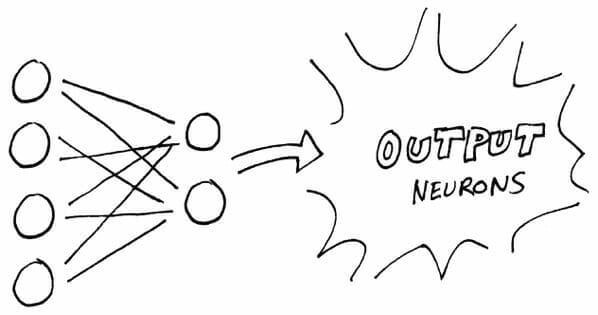
Picture nodes in a neural network as players in a marching band and each row of band members as a layer. Assume that none of the players knows the music to be played or how to move during the performance. Only the front row of band members can see the band leader (the drum major). The drum major gives the first row a signal that's passed through the remaining rows (layers), enabling all players to coordinate their movements and the playing of their instruments.

At first, players would be bumping into one another and playing the wrong notes, but with more and more practice, the players would get in sync and perform as a unit. They would learn.
To smooth the learning curve, the band creates a system that enables band members to provide feedback. As they move and play, the band members choose numbers that indicate their level of confidence (say from 0 to 100 percent) that they are doing it right. Based on each band member's confidence level, neighboring band members make small adjustments and then check to see whether their adjustments increased or decreased their neighbor's confidence level. The goal is to achieve a 100 percent confidence level for all band members.
The idea here is that this neural marching band network will learn on its own without additional input or correction from an outside source. Theoretically, at least, the nodes will eventually make enough small adjustments to produce the correct output (a stellar performance) through trial and error, learning from their mistakes.
As you can imagine, learning by trial and error can be very chaotic and time-consuming, especially when you have multiple entities making their own adjustments based on input from numerous other entities. In the case of our fictional marching band, band members would be bumping into one another and playing the wrong notes for hours, days, or weeks before they actually coordinated their efforts.
To overcome this challenge, AI developers attempt to tweak the network to make it more efficient. For example, suppose you gave more weight to feedback from the drummers because they set the rhythm. Perhaps you give their confidence level four times the importance as other band members. Now, when the band members make adjustments, they look more to the drummers to determine the net impact of the adjustments they made, and the marching band learns much faster.
Eventually, the band delivers a nicely choreographed and well-orchestrated performance to the output layer. If this were a neural network, the output could then be stored, and whenever instructed to do so, it could repeat its performance. In addition, the strengthened connections between certain neurons might make learning new musical arrangements easier.
In a previous post AI Learning vs Memorizing? I discuss how machine learning developed as a way to overcome certain limitations in the early days of artificial intelligence. Without machine learning, machines would be able to do only what they were told or were programmed to do. Machine learning expands their capabilities beyond what they were merely programmed to do.
As shown below, here are examples of machine learning applications across a wide variety of fields ranging from data security and software development to investing and healthcare.
One of the best ways to understand machine learning is to look at the various applications of machine learning in the real world:
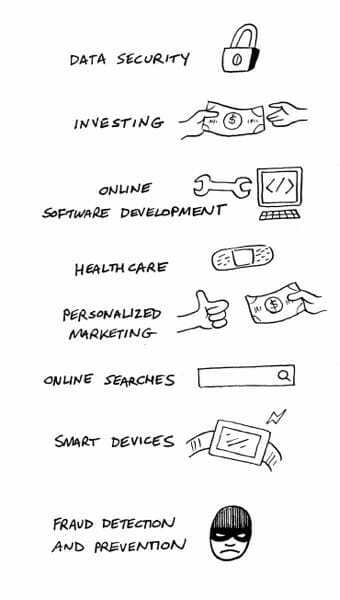
These are only a few of the vast number of machine learning applications that are possible. As machine learning matures, you are likely to see many more real-world applications and consumer products and services driven by machine learning.
The symbolic systems approach and AI planning work great for applications that have a limited number of matching patterns; for example, a program that helps you complete your tax return. The IRS provides a limited number of forms and a collection of rules for reporting tax-relevant data. Combine the forms and instructions with the capability to crunch numbers and some heuristic reasoning, and you have a tax program that can step you through the process. With heuristic reasoning, introduced in the previous chapter, you can limit the number of patterns; for example, if you earned money from an employer, you complete a W-2 form. If you earned money as a sole proprietor, you complete Schedule C.
The limitation with this approach is that the database is difficult to manage, especially when rules and patterns change. For example, malware (viruses, spyware, computer worms and so forth) evolve too quickly for anti-malware companies to manually update their databases. Likewise, digital personal assistants, such as Siri and Alexa, need to constantly adapt to unfamiliar requests from their owners.
To overcome these limitations, early AI researchers started to wonder whether computers could be programmed to learn new patterns. Their curiosity led to the birth of machine learning — the science of getting computers to do things they weren't specifically programmed to do.
Machine learning got its start very shortly after the first AI conference. In 1959, AI researcher Arthur Samuel created a program that could play checkers. This program was different. It was designed to play against itself so it could learn how to improve. It learned new strategies from each game it played and after a short period of time began to consistently beat its own programmer.
A key advantage of machine learning is that it doesn't require an expert to create symbolic patterns and list out all the possible responses to a question or statement. On its own, the machine creates and maintains the list, identifying patterns and adding them to its database.
Imagine machine learning applied to the Chinese room experiment. The computer would observe the passing of notes between itself and the person outside the room. After examining thousands of exchanges, the computer identifies a pattern of communication and adds common words and phrases to its database. Now, it can use its collection of words and phrases to more quickly decipher the notes it receives and quickly assemble a response using these words and phrases instead of having to assemble a response from a collection of characters. It may even create its own dictionary based on these matching patterns, so it has a complete response to certain notes it receives.
Machine learning still qualifies as weak AI, because the computer doesn't understand what's being said; it only matches symbols and identifies patterns. The big difference is that instead of having an expert provide the patterns, the computer identifies patterns in the data. Over time, the computer becomes "smarter."
Machine learning has become one of the fastest growing areas in AI primarily because the cost of data storage and processing has dropped dramatically. We are currently in the era of data science and big data — extremely large data sets that can be computer analyzed to reveal patterns, trends and associations. Organizations are collecting vast amounts of data. The big challenge is to figure out what to do with all this data. Answering that challenge is machine learning, which can identify patterns even when you really don't know what you're looking for. In a sense, machine learning enables computers to find out what's inside your data and let you know what it found.
Machine learning moves past the limitations with symbolic systems. Instead of memorizing symbols a computer system uses machine learning algorithms to create models of abstract concepts. It detects statistical patterns by using machine learning algorithms on massive amounts of data.
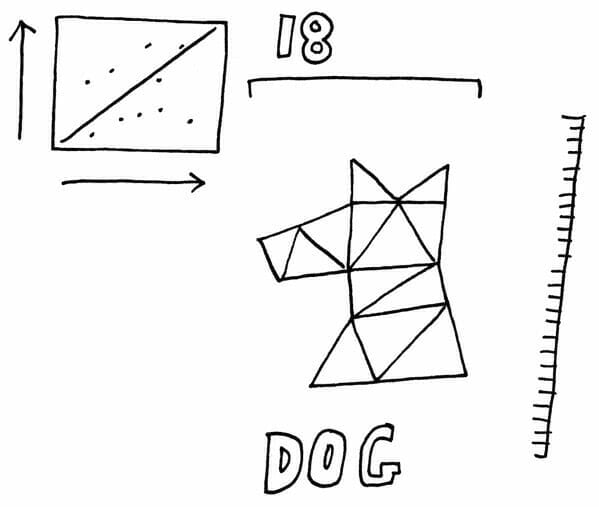
So a machine learning algorithm looks at the eight pictures of different dogs. Then it breaks down these pictures into individual dots or pixels. Then it looks at these pixels to detect patterns. Maybe it sees a pattern all of these animals as having hair. Maybe it sees a pattern for noses or ears. It could even see a pattern that humans are unable to perceive. Collectively, the patterns create what might be considered a statistical expression of “dogness.”
Sometimes humans can help machines learn. We can feed the machine millions of pictures that we’ve already determined contained dogs, so the machine doesn’t have to worry about excluding images of cats, horses or airplanes. This is called supervised learning, and the data, consisting of the label “dog” and the millions of pictures of dogs is called a training set. Using the training set, a human being is teaching the machine that all of the patterns it identifies are characteristics of “dog.”
Machines can also learn completely on their own. We just feed massive amounts of data into the machine and let it find its own patterns. This is called unsupervised learning.
Imagine a machine examining all the pictures of people on your smart phone. It might not know if someone was your husband, wife, boyfriend or girlfriend. But it could create clusters of people that it sees are closest to you.
In one of my previous posts Solve General Problems with Artificial Intelligence, I discussed an approach to artificial intelligence (AI) referred to as the physical symbol system hypothesis (PSSH). The theory behind this approach is that human intelligence consists of the ability to take symbols (recognizable patterns), combine them into structures (expressions), and manipulate them using various processes to produce new expressions.
As philosopher John Searle pointed out with his Chinese room argument, this ability, in and of itself, does not constitute intelligence, because it requires no understanding of the symbols or expressions. For example, if you ask your virtual assistant (Siri, Alexa, Bixby, Cortana, etc.) a question, it searches through a list of possible responses, chooses one, and provides that as the answer. It doesn't understand the question and has no desire to answer the question or to provide the correct answer.
AI built on the PSSH is proficient at storing lots of data (memorization) and pattern-matching, but it is not so good at learning. Learning requires the ability not only to memorize but also to generalize and specify.
Human evolution has made us experts at memorization, generalization, and specification. To a large degree, it is how we learn. We record (memorize) details about our environment, experiences, thoughts, and feelings; form generalizations that enable us to respond appropriately to similar environments and experiences in the future; and then fine-tune our impressions through specification. For example, if you try to pet a dog, and it snaps at you, you may generalize to avoid dogs in the future. However, over time, you develop more nuanced thoughts about dogs—that not all dogs snap when you try to pet them and that there are certain ways to approach dogs that make them less likely to snap at you.
The combination of memorization, generalization, and specification is a valuable survival skill. It also plays a key role in enabling machine learning — providing machines with the ability to recognize unfamiliar patterns based on what they already "know" about familiar patterns.
Look at the following eight images. You can tell that the eight images represent different breeds of dogs, even though these aren't photographs of actual dogs.
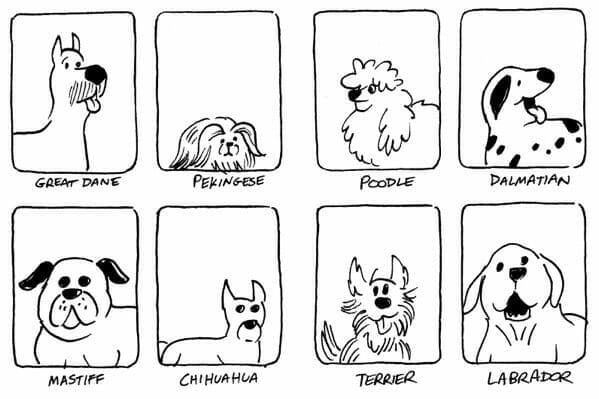
You know that these are all pictures of dogs, because you have encountered many dogs in your life (in person, in photos and drawings, and in videos), and you have formed in your mind an abstract idea of what a dog looks like.
In their early stages of learning, children often overgeneralize. For example, upon learning the word "dog," they call all furry creatures with four legs "dog." To these children, cats are dogs, cows are dogs, sheep are dogs, and so on. This is where specification comes into play. As children encounter different species of four-legged mammals, they begin to identify the qualities that make them distinct.
Computers are far better at memorization and far worse at generalization and specification. The computer could easily memorize the eight images of dogs, but if you fed the computer a ninth image of a dog, as shown below, it would likely struggle to match it to one of the existing images and identify it as an image of a dog. In other words, the computer would quickly master memorization and pattern-matching but struggle to learn due to its inability to generalize and specify.

For this same reason, language translation programs have always struggled with accuracy. Developers have created physical symbol systems that translate words and phrases from one language to another, but these programs never really learn the language. Instead, they function merely as an old-fashioned foreign language dictionary and phrasebook — quickly looking up words and phrases in the source language to find the matching word or phrase in the destination language and then stitching together the words and phrases to provide the translation. These translation programs often fail when they encounter unfamiliar words, phrases, and even syntax (word order).
Currently, machines have the ability to learn. The big challenge in the future of AI learning and machine learning will be to enable machines to do a better job of generalizing and specifying. Instead of merely matching memorized symbols, newer machines will create abstract models based on the patterns they observe (the patterns they are fed). These models will have the potential to help these machines learn more effectively, so they can more accurately interpret unfamiliar future input.
As machines become better at generalizing and specializing, they will achieve greater levels of intelligence. It remains to be seen, however, whether machines will ever have the capacity to develop self-awareness and self-determination — key characteristics of human intelligence.
AI Planning Systems is a branch of Artificial Intelligence whose purpose is to identify strategies and action sequences that will, with a reasonable degree of confidence, enable the AI program to deliver the correct answer, solution, or outcome.
As I explained in a previous article Solve General Problems with Artificial Intelligence, one of the limitations of early AI, which was based on the physical symbol system hypothesis (PSSH), is combinatorial explosion — a mathematical phenomenon in which the number of possible combinations increases beyond the computer's capability to explore all of them in a reasonable amount of time.
AI planning attempts to solve the problem of combinatorial explosion by using something called heuristic reasoning — an approach that attempts to give artificial intelligence a form of common sense. Heuristic reasoning enables an AI program to rule out a large number of possible combinations by identifying them as impossible or highly unlikely. This approach is sometimes referred to as "limiting the search space."
A heuristic is a mental shortcut or rule-of-thumb that enables people to solve problems and make decisions quickly. For example, the Rule of 72 is a heuristic for estimating the number of years it would take an investment to double your money. You divide 72 by the rate of return, so an investment with a 6% rate of return would double your money in about 72/6 = 12 years.
Heuristic reasoning is common in innovation. Inventors rarely consider all the possibilities for solving a particular problem. Instead, they start with an idea, a hypothesis, or a hunch based on their knowledge and prior experience, then they start experimenting and exploring from that point forward. If they were to consider all the possibilities, they would waste considerable time, effort, energy, and expertise on futile experiments and research.
With AI planning, you might combine heuristic reasoning with a physical symbol system to improve performance. For example, imagine heuristic reasoning applied to the Chinese room experiment I introduced in my previous post on the general problem solver.
In the Chinese room scenario, you, an English-only speaker, are locked in a room with a narrow slot on the door through which notes can pass. You have a book filled with long lists of statements in Chinese, and the floor is covered in Chinese characters. You are instructed that upon receiving a certain sequence of Chinese characters, you are to look up a corresponding response in the book and, using the characters strewn about the floor, formulate your response.
What you do in the Chinese room is very similar to how AI programs work. They simply identify patterns, look up entries in a database that correspond to those patterns, and output the entries in response.
With the addition of heuristic reasoning, AI could limit the possibilities of the first note. For example, you could program the software to expect a message such as "Hello" or "How are you?” In effect, this would limit the search space, so that the AI program had to search only a limited number of records in its database to find an appropriate response. It wouldn't get bogged down searching the entire database to consider all possible messages and responses.
The only drawback is that if the first message was not one of those that was anticipated, the AI program would need to search its entire database.
Heuristic reasoning is commonly employed in modern AI applications. For example, if you enter your location and destination in a GPS app, the app doesn't search its vast database of source data, which consists of satellite and aerial imagery; state, city, and county maps; the US Geological Survey; traffic data; and so on. Instead, it limits the search space to the area that encompasses the location and destination you entered. In addition, it limits the output to the fastest or shortest route (not both) depending on which setting is in force, and it likely omits a great deal of detail from its maps to further expedite the process.
The goal is to deliver an accurate map and directions, in a reasonable amount of time, that lead you from your current location to your desired destination as quickly as possible. Without the shortcuts to the process provided by heuristic reasoning, the resulting combinatorial explosion would leave you waiting for directions... possibly for the rest of your life.
Even though many of the modern AI applications are built on what are now considered old-fashioned methods, AI planning allows for the intelligent combination of these methods, along with newer methods, to build AI applications that deliver the desired output. The resulting applications can certainly make computers appear to be intelligent beings — providing real-time guidance from point A to point B, analyzing contracts, automating logistics, and even building better video games.
If you're considering a new AI project, don't be quick to dismiss the benefits of good old-fashioned AI (GOFAI). Newer approaches may not be the right fit.
In one of my previous posts "The General Problem Solver," I discuss the debate over whether a physical symbol system is necessary and sufficient for intelligence. The developers of one of the early AI programs were convinced it did, but philosopher John Searle presented his Chinese room argument as a rebuttal to this theory. Searle concluded that a machine's ability to store and match symbols (patterns) to find the answers to questions or to solve problems does not constitute intelligence. Instead, intelligence requires an understanding of the question or problem, which a machine does not have.
Searle went on to distinguish between two types of artificial "intelligence" — weak AI and strong AI:
● Weak AI is confined to a very narrow task, such as Netflix recommending movies or TV shows based on a customer's viewing history, finding a website that is likely to contain the content a user is looking for, or analyzing loan applications and determining whether a candidate should be approved or rejected. A weak AI program does not understand questions, experience emotions, care about anything or anyone, or learn for the sake of learning. It merely performs whatever task it was designed to do.
● Strong AI exhibits human characteristics, such as emotions, understanding, wisdom, and creativity. Examples of strong AI come from science fiction—HAL (the Heuristically programmed ALgorithmic computer) that controls the spaceship in 2001: A Space Odyssey, Lieutenant Commander Data from Star Trek, and C3PO and R2-D2 from Star Wars. These mechanical, computerized beings have emotions, self-awareness, and even a sense of humor. They are machines capable of learning new tasks — not limited to the tasks they have been programmed to perform.
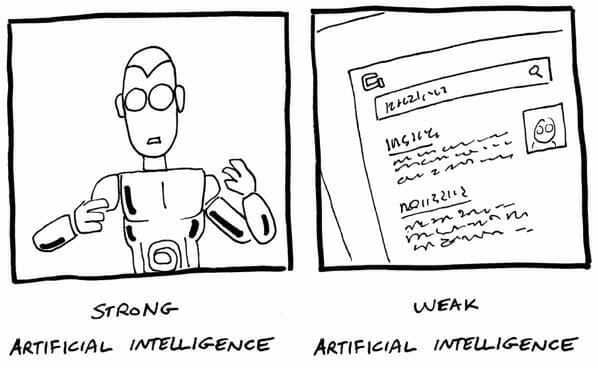
Just Getting Started
Contrary to what science fiction writers want us to believe and the dark warnings in the media about intelligent robots eventually being able to take over the world and enslave or eradicate the human race, most experts believe that we’re just getting rolling with weak AI. Currently, AI and machine learning systems are being used to answer fact-based questions, recommend products, improve online security, prevent fraud, and perform a host of other specific tasks that rely on processing lots of data and identifying patterns in that data. Strong AI remains relegated to the world of science fiction.
Weak AI is more of an illusion of intelligence. Developers combine natural language processing (NLP) with pattern matching to enable machines to carry out spoken commands. The experience is not much different from using a search engine such as Google or Bing to answer questions or asking Netflix for movie recommendations. The only difference is that the latest generation of virtual assistants, including Apple's Siri, Microsoft's Cortana, and Amazon's Alexa, respond to spoken language and are able to talk back. They can even perform some basic tasks, such as placing a call, ordering a product online, or booking a reservation at your favorite restaurant.
In addition, the latest virtual assistants have the ability to learn. If they misinterpret what you say (or type), and you correct them, they learn from the mistake and are less likely to make the same mistake in the future. If you use a virtual assistant, you will notice that, over time, they become much more in tune with the way you express yourself. If someone else joins the conversation, the virtual assistant is much more likely to struggle to interpret what that person says.
This ability to respond to voice commands and adapt to different people's vocabulary and pronunciation may appear to be a sign of intelligent life, but it is all smoke and mirrors — valuable, but still weak AI.
Weak AI also includes expert systems — software programs that use databases of specialized knowledge along with processes, such as decision trees, to offer advice or make decisions in areas such as loan approvals, medical diagnosis, and choosing investments. In the U.S. alone, about 70 percent of overall trading volume is driven by algorithms and bots (short for robots). Expert systems are also commonly used to evaluate and approve or reject loan applications. Courts are also discussing the possibility of replacing judges with experts systems for more consistency (less bias) in rendering verdicts and punishments.
To create expert systems, software developers team up with experts in a given field to determine the data the experts need to perform specific tasks, such as choosing a stock, reviewing a loan application, or diagnosing an illness. The developers also work with the experts to figure out what steps the experts take in performing those tasks and the criteria they consider when making a decision or formulating an opinion. The developers then create a program that replicates, as closely as possible, what the expert does.
Developers may even program learning into an expert system, so that the system can improve over time as more data is collected and analyzed and as the system is corrected when it makes mistakes.
Although weak AI is still fairly powerful, it does have limitations, particularly in the following areas:
● Common sense: AI responds based on the available data — just the facts, as presented to it. It doesn't question the data, so if it has bad data, it may make bad decisions or offer bad advice. Specifically in the area of the stock market, bad data could trigger an unjustified selloff and, because the bots can execute trades so quickly, that could lead to considerable financial losses for investors.
● Emotion: Computers cannot offer the emotional understanding and support that people often need, although they can fake it to some degree with emotional language.
● Wisdom: While computers can store and recall facts, they lack the ability to discern less quantifiable qualities, such as character, commitment, and credibility — an ability that may be required in some applications.
● Creativity: Computers cannot match humans when it comes to innovation and may never be able to do so. While computers can plod forward to solve problems, they do not make the mental leaps that humans are capable of making. In exploring all the possibilities to solve a problem, for example, computers are susceptible to combinatorial explosions — a mathematical phenomenon in which the number of possible combinations increases beyond the computer's capability to explore all of them in a reasonable amount of time.
Given its limitations, weak AI is unlikely to ever replace human beings in certain roles and functions. A more likely scenario is what we are now seeing — people teaming up with AI systems to perform their jobs better and faster. While humans provide the creativity, emotion, common sense, and wisdom that machines lack, machines provide the speed, accuracy, thoroughness, and objectivity often lacking in humans.
In a previous post entitled "Playing the Imitation Game," I discussed Alan Turing's vision, published in 1936, of a single, universal machine that could be programmed to solve any particular problem. In 1959, Allen Newell and Herbert A. Simon took a different approach. Their goal was to develop a computer program that could function as a universal problem solver.
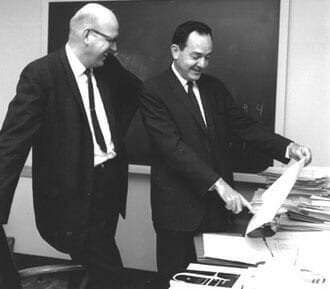
Newell and Simon - Courtesy Carnegie Mellon University Libraries
In theory, their general problem solver (GPS) would be able to solve any problem that could be presented in the form of specific types of mathematical formulas that are useful in programming logic. This type of problem would include geometric proofs, which start with definitions, axioms (statements accepted as fact), postulates, and previously proven theorems, and use logic to arrive at reasoned conclusions.
One of the problems GPS solved was the Tower of Hanoi — a game or puzzle consisting of three rods and a number of disks of different sizes, which can slide onto any rod.

When you start, all the disks are on one rod, ordered from largest to smallest from the bottom up. The goal is to move the entire stack to another rod in the least number of moves following these rules:
● Move only one disk at a time.
● Do not place a larger disk on top of a smaller one.
● Each move consists of taking the top disk from one stack and placing it on an empty rod or on the top of an existing stack.
The minimum number of moves to solve the Tower of Hanoi is 2n – 1, where n is the number of disks, so for three disks, the minimum number of moves is (2 x 2 x 2) – 1 = 7.
One of the key parts of the general problem solver was what Newell and Simon called the physical symbol system hypothesis (PSSH). According to Newell and Simon, "A physical symbol system has the necessary and sufficient means for general intelligent action." Such a system would be able to take patterns (symbols), combine them into structures (expressions), and manipulate them using various processes to produce new expressions.
Newell and Simon believed that human intelligence was no more than a complex physical symbol system. They thought that a key part of human reasoning consisted merely of connecting symbols — that our language, ideas, and concepts were just broad groupings of interconnected symbols. For example, when we see a chair or a picture of a chair, we associate it with the act of sitting. When we smell smoke, we associate it with fire, which is associated with danger, which may trigger a fight-or-flight response.
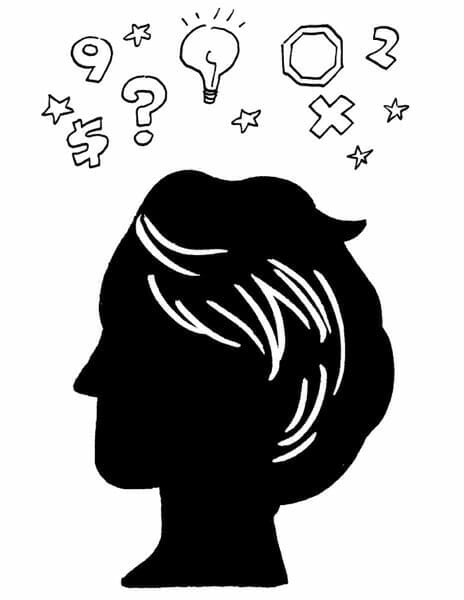
Newell and Simon argued that by feeding a machine enough physical symbols, creating a sufficient number of associations, and putting rules in place for combining symbols into structures and manipulating them to create new expressions, machines could be made to "think" like we humans do. This theory forms the basis of what drives most of machine learning and artificial intelligence to this day.
Not everyone buys into the notion that a physical symbol system is necessary and sufficient for human intelligence. In 1980, philosopher John Searle argued that merely connecting symbols could not be considered intelligence. To support his argument against the idea that manipulating physical symbols constituted intelligence, he presented what is commonly referred to as the Chinese room argument.
Imagine yourself, an English-only speaker, locked in a room with a narrow slot on the door through which you can pass notes. You have a book filled with long lists of statements in Chinese, and the floor is covered in Chinese characters. You are instructed that upon receiving a certain sequence of Chinese characters, you are to look up a corresponding response in the book and, using the characters strewn about the floor, formulate your response.
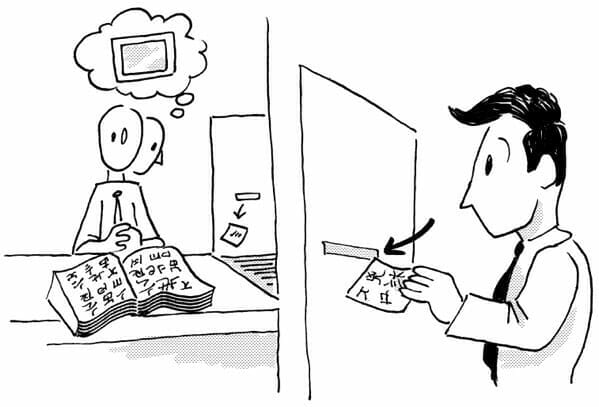
Someone outside the room who speaks and writes fluent Chinese writes a note on a sheet of paper and passes it to you through the slot on the door. Following the instructions you were given, you look up a response in the book, copy the response using characters from the floor to create your note, and pass it through the slot to the person who delivered the original message.
The native speaker may believe that the two of you are communicating and that you know the language. However, Searle argues that this is no proof of intelligence, because you have no understanding of the messages you are receiving or sending.
You can try a similar experiment with your smart phone. If you ask Siri or Alexa how she's feeling, she will answer your question even though she feels nothing at all. She doesn't even understand the question. This artificially "intelligent" being is merely matching your question to what is considered an acceptable answer and delivering that answer to you.
A huge obstacle to achieving artificial intelligence through a physical symbol system is what's known as combinatorial explosion — the rapid growth of symbol combinations that makes pattern-matching increasingly difficult. Combinatorial explosion is far greater than exponential growth. The formula for exponential growth can be expressed as y = 2x, whereas the formula for combinatorial explosion is y = x! (the factorial of x). For example, if x = 20, then
exponential growth: y = 2x = 220 = 2 x 2 x 2 x 2 x 2 x 2 x 2 x 2 x 2 x 2 x 2 x 2 x 2 x 2 x 2 x 2 x 2 x 2 x 2 x 2 = 1,048,576
combinatorial explosion: y = x! = 1 x 2 x 3 x 4 x 5 x 6 x 7 x 8 x 9 x 10 x 11 x 12 x 13 x 14 x 15 x 16 x 17 x 18 x 19 x 20 = 2,432,902,008,176,640,000
With each added symbol, the number of combinations increases dramatically. Considering all the possible combinations would require immense computational resources over a considerable amount of time.
Even with these challenges, pattern-matching has remained the cornerstone of artificial intelligence, regardless of whether it is even in the same ballpark as human intelligence.
The Imitation Game is a 2015 movie based on the biography of Alan Turing, a Cambridge and Princeton graduate. In 1939, Turing was recruited by the newly created British intelligence agency MI6 to decipher Nazi codes, including Enigma. The Polish had broken the Enigma code before the war, but the Nazis increased the complexity of their Enigma machines, so there were approximately 10114 permutations to the code. At the time, the British code-breaking operation involved 12,000 people who covered three shifts that operated 24/7. Turing and his team built an electromechanical machine called the Bombe that searched through the permutations of the Enigma code to find the one that was used for each message. Using the Bombe, the British were able to read all of the German navy's encrypted messages.
While working toward his Ph.D. at Princeton, Turing published a paper entitled "On Computable Numbers with an application to the Entscheidungs problem," in which he envisioned a single, universal machine that could solve any problem by following instructions that could be encoded on a paper tape. For example, given one set of instructions, the machine might be able to calculate square roots. Given another set of instructions, it could solve crossword puzzles. Although others have been credited with inventing the first computer, Turing's ideas gave birth to the field of computer science, specifically computer programming.
In a 1951 paper, Turing proposed a test for intelligence called the “imitation game,” which is based on a Victorian parlor game. The game involves three players—Player A is a man, Player B is a woman, and Player C is a man or woman who acts as the interrogator. Player C cannot see Players A or B and can communicate with them only through written messages. Player C writes down questions that are passed to Player A or B and receives written answers back from them. Based on the answers, Player C must determine which player (A or B) is the man and which is the woman. Player A's job is to trick Player C into making the wrong choice, while player B attempts to assist Player C in making the right choice.
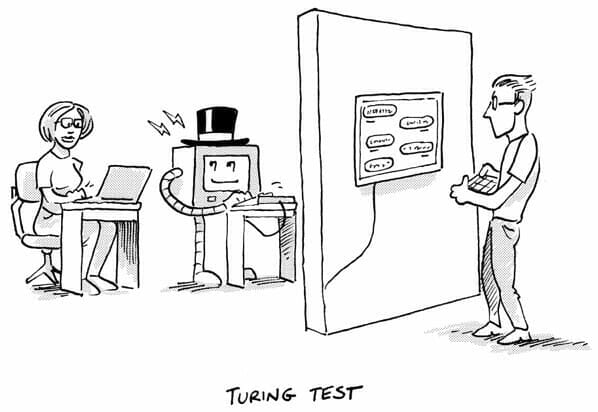
Turing imagined an updated version of the imitation game in which Player A is replaced by a machine. If the machine were just as effective as a human player in fooling Player C, Turing deemed this proof of (artificial) intelligence. The imitation game later came to be referred to as the "Turing test."
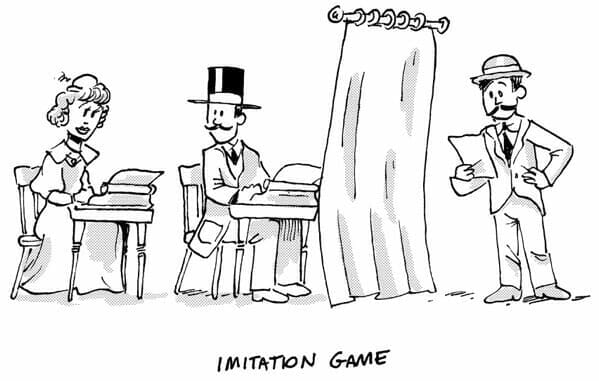
This test sparked a lot of curiosity in the possibility of an "intelligent machine"—one that could accomplish a specific task in the presence of uncertainty and variations in its environment. For a machine to be considered intelligent, it must be able to monitor its environment and make adjustments based on its observations. In the case of the Turing test, the machine would need to be able to "understand" its role in the game (to fool Player C) and its gender (male) and be able to choose responses to unanticipated questions in a way that would confuse Player C.
Even after nearly 70 years, this test is still intriguing and a considerable challenge for computer developers. You can witness a version of this today by interacting with smartphones and artificially intelligent virtual assistants, like Siri and Alexa, whose answers to questions and responses to directives are often comical at best.
Most experts agree that the Turing test is not necessarily the best way to gauge intelligence. For one it depends a lot on the interrogator—some people are easily fooled. It also assumes that artificial intelligence is like human intelligence and that computers have mastered verbal communication, when that is far from the truth; computers often misinterpret words and phrases. If a computer cannot carry on an intelligent conversation, then how can we expect it to perform higher level tasks that require the ability to accurately interpret verbal and non-verbal communication, such as accurately diagnosing an illness?
The Turing test still inspires a lot of innovation. Companies continue to try to create intelligent chatbots, for example, and there are still natural language processing (NLP) competitions that attempt to pass the test. Indeed, it seems as though modern machines are only a few years away from passing the Turing test. Many modern NLP applications are able to accurately understand many of your requests. Now they just have to improve their ability to respond.
Yet even if a machine is able to pass the Turing test, it still seems unlikely that that same machine would qualify as intelligent. Even if your smartphone is able to trick you into thinking you’re talking to a human, that doesn’t mean that it will offer meaningful conversation or care about what you think or feel.
To understand the concept of artificial intelligence, we must first start by defining intelligence. According to the dictionary definition, intelligence is a "capacity for learning, reasoning, understanding, and similar forms of mental activity; aptitude for grasping truths, relationships, facts, meanings, etc." This definition is broad enough to cover both human and computer (artificial) intelligence. Both people and computers can learn, reason, understand relationships, distinguish facts from falsehoods and so forth.
However, some definitions of intelligence raise the bar to include consciousness or self-awareness, wisdom, emotion, sympathy, intuition and creativity. In some definitions, intelligence also involves spirituality — a connection to a greater force or being. These definitions separate natural, human intelligence from artificial intelligence, at least in the current, real world. In science fiction, in futuristic worlds, artificially intelligent computers and robots often make the leap to self-consciousness and self-determination, which leads to conflict with their human creators. In The Terminator, artificial intelligence leads to all-out war between humans and the intelligent machines they created.
A further challenge to our ability to define “intelligence” is the fact that human intelligence comes in many forms and often includes the element of creativity. While computers can be proficient at math, repetitive tasks, playing certain games (such as chess), and anything else a human being can program them to do (or to learn to do), people excel in a variety of fields, including math, science, art, music, politics, business, medicine, law, linguistics and so on.
Another challenge to defining intelligence is that we have no definitive standard for measuring it. We do have intelligent quotient (IQ) tests, but a typical IQ test evaluates only short-term memory, analytical thinking, mathematical ability and spatial recognition. In high school, we take ACTs and SATs to gauge our mastery of what we should have learned in school, but the results from those tests don't always reflect a person's true intelligence. In addition, while some people excel in academics, others are skilled in trades or have a higher level of emotional competence or spirituality. There are also people who fail in school but still manage to excel in business, politics, or their chosen careers.
Without a reliable standard for measuring human intelligence, it’s very difficult to point to a computer and say that it's behaving intelligently. Computers are certainly very good at performing certain tasks and may do so much better and faster than humans, but does that make them intelligent? For example, computers have been able to beat humans in chess for decades. IBM Watson beat some of the best champions in the game show Jeopardy. Google's DeepMind has beaten the best players in the 2,500-year-old Chinese game called “Go” — a game so complex that there are thought to be more possible configurations of the board than there are atoms in the universe. Yet none of these computers understands the purpose of a game or has a desire to play.
As impressive as these accomplishments are, they are still just a product of a computer’s special talent for pattern-matching. Pattern-matching is what happens when a computer extracts information from its database and uses that information to answer a question or perform a task. This seems to be intelligent behavior only because a computer is excellent at that particular task. However, excellence at performing a specific task is not necessarily a reflection of intelligence in a human sense. Just because a computer can beat a chess master does not mean that the computer is more intelligent. We generally don't measure a machine's capability in human terms—for example, we don't describe a boat as swimming faster than a human or a hydraulic jack as being stronger than a weightlifter—so it makes little sense to describe a computer as being smarter or more intelligent just because it is better at performing a specific task.

A computer's proficiency at pattern-matching can make it appear to be intelligent in a human sense. For example, computers often beat humans at games traditionally associated with intelligence. But games are the perfect environments for computers to mimic human intelligence through pattern-matching. Every game has specific rules with a certain number of possibilities that can be stored in a database. When IBM's Watson played Jeopardy, all it needed to do was use natural language processing (NLP) to understand the question, buzz in faster than the other contestants, and apply pattern-matching to find the correct answer in its database.
Early AI developers knew that computers had the potential to excel in a world of fixed rules and possibilities. Only a few years after the first AI conference, developers had their first version of a chess program. The program could match an opponent’s move with thousands of possible counter moves and play out thousands of games to determine the potential ramifications of making a move before deciding which piece to move and where to move it, and it could do so in a matter of seconds.
Artificial intelligence is always more impressive when computers are on their home turf — when the rules are clear and the possibilities limited. Organizations that benefit most from AI are those that work within a well-defined space with set rules, so it’s no surprise that organizations like Google fully embrace AI. Google’s entire business involves pattern-matching — matching users’ questions with a massive database of answers. AI experts often refer to this as good old-fashioned artificial intelligence (GOFAI).
If you're thinking about incorporating AI in your business, consider what computers are really good at — pattern-matching. Do you have a lot of pattern-matching in your organization? Does a lot of your work have set rules and possibilities? It will be this work that is first to benefit from AI.
In 1993, I worked for a print clothing catalog called Spiegel. It was located in a beautiful glass building outside of Chicago. At the time Spiegel were just starting to think about their first website. They wanted a web billboard that advertised their toll free number. They figured web visitors wanted to call for a print catalog.
To do this they formed a small “Internet team.” The art directors thought the Internet seemed like a technical challenge so they asked the networking team to create the site.
A few days later the team demonstrated their work.
The new Spiegel homepage had a jet black background. Almost like a computer terminal. At the top there were lime green letters that spelled out “welcome to Spiegel Inc.” Just below the title there was a GIF of a young woman in black lingerie.
The room of directors watched patiently as the image loaded. At the time the compressed GIF images twisted into clarity like a slow motion video. The effect was almost like a Venetian blind. Every other line opened until the image came into focus.
When the website fully loaded all the art directors sat in silence. One director took off his glasses and pinched the bridge of his nose. He asked, “how many people are on this Internet?”
It was a strange presentation. There were four network technicians designing the look and feel of the new site. The presentation was on the same floor with a hundred designers, copywriters and art directors. Each one with training, experience and talent. They all typed in QuarkXPress, unaware of the presentation in the glass room.
To their credit, the art directors immediately saw that the webpage was not a technical challenge. It was a creative challenge. It was one that their art teams were more than qualified to handle. They respected the importance of technology, but they also recognized that their customers placed the highest value on their curated "high touch" content. Their customers trusted the Spiegel brand because it represented good taste.
In the end this was the overall trend of the web. While at the time it seemed like the World Wide Web would be a boon for network engineers, it actually turned out to be a growing area for graphic designers, artists, filmmakers and photographers. It was easier to create web-savvy designers than it was to create design-savvy network engineers.

You can see this in the overall increase of the number of graphic designers over a period of ten years.
If you fast forward to today you can see that the same should hold true for artificial intelligence. Right now it seems like it will be a boon for engineers and computer programmers. That's why universities are putting emphasis on STEM programs and predictive analytics. There are proposed slashes to the National Endowment for the Arts and the Japanese education minister ordered the elimination of the humanities from Japanese universities.
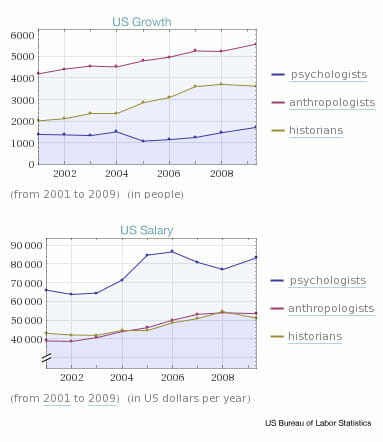
The last ten years have been pretty flat for those who specialize in the humanities. Anthropologists, psychologists and historians have fared much worse than quantitative fields such as software development and data science.
Yet AI will offer an increased demand for these same fields. It’s these professionals that will help bridge the gap between humans and their artificial agents.
Back in the early 90s it was all the rage to give your site a better user experience. That's why there was emphasis on design. You wanted better buttons, better icons and just the right color gradient.
With artificial intelligence all the emphasis will be on creating a better human experience. That's why you’ll need artists, anthropologists, psychologists and cultural experts. If you want your machines to offer better human experience in China then you're gonna need someone who understands Chinese. Not just the languages but the art, culture and history.
Some large technology companies are already starting to move in this direction. Luke Dormehl talks about this in his new book, Thinking Machines: The Quest for Artificial Intelligence--and Where It's Taking Us Next.
In the book he points out that a few years ago Apple introduced its new music streaming service. They might have used a classic AI approach to curating music lists. There were AI tools like machine learning that could train large data sets and compare you to other customers. Anytime a new song came out the machine would predict the best audience.
They might have used neural networks to categorize music based on tempo, genre and many other criteria. Any time a new song was released the neural network would match it to popular categories.
In the end Apple decided to use a creative high touch approach. They hired human DJs. Like the designers and artists at Spiegel they specialized at being creative and having good taste. They didn't rely on past data and current trends. Instead they focused on creating trends and understanding the more social aspects of listening to music. They focused on creating a service that told you what you should like and didn’t just parrot back what you might like.

Even though Apple is one of the largest employers of human DJs, we’re still a long way from a DJ driven economy. A recent paper from the Oxford Martin School concluded that in two decades automation may pull as much as 47% of jobs out of the US economy. At the end of their paper they list 700 occupations that are in danger of computer automation.
At the very top of the list they had fifty or so occupations that are in the least danger of being replaced by automation. Most of them were high touch occupations. These were jobs that were creative and had to work with nonlinear data. Occupations like therapists, social workers, sales specialists, physicians, detectives and teachers. Only one IT occupation made it to the top fifty and that was the always nimble computer systems analyst.
These occupations are difficult to automate because they rely too much on creativity, empathy and human interaction. Artificial intelligence will never become fully intelligent about humans without these teams that specialize in human behavior. Artificial intelligence can tell you how we do things, but it still stumbles when deciding why we do them.
It turns out it's much easier to make sense of the data than it is to make sense of human behavior.
This is the topic of a book titled Sensemaking: The Power of Humanities and the Age of the Algorithm. In it Christian Madsbjerg points out that data on behavior and understanding of humanity are two different things. It's almost like the difference between seeing an animal in the wild and in the zoo.
When you go to the zoo and you see a lion it might seem like you're looking at a lion. It might walk like a lion, smell like a lion and even roar like a lion. It in the end you're not really looking at a lion. You’re looking at an animal in the zoo. To really understand what it means to be a lion you have to go to the savanna. You have to understand the animal in the context of its habitat and surroundings.
Artificial intelligence can tell you everything that you want to know about an animal in the zoo, but you need someone who knows about the savanna to truly understand what it means to be a lion.
Understanding culture and context are key part of a liberal education. AI tools can help categorize and make decisions about data, but you need creative fields and the humanities to understand the meaning. Employers are already asking for these skills. Close to 80% say that “broad knowledge of the liberal arts” and “intercultural skills” are somewhat or very important.
As AI increases its capacity to mimic our behavior there will be broad questions about culture, empathy and creativity. When these questions are discussed no one deserves a seat at the table more than the artists, psychologists and humanities professionals that passionately pursue these subjects.